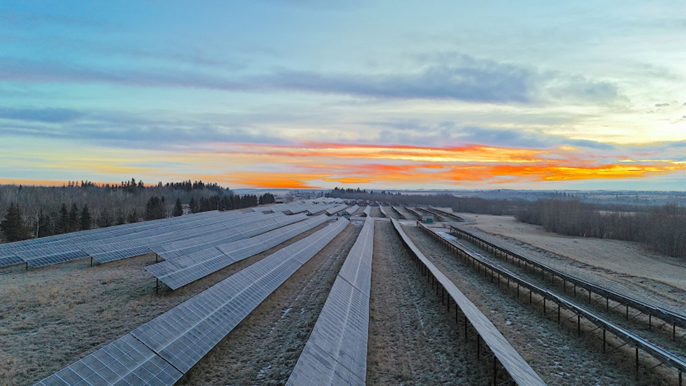The Emerald Award-winning Salay Prayzaan at Métis Crossing Solar Project is a collaboration between two municipalities, the Town of Smoky Lake and Smoky Lake County, and an Indigenous community, the Métis Nation of Alberta. Additionally, the team at Alberta Innovates was essential in framing this challenge and guiding the process.
The project received a $3.9 million investment from the Municipal Climate Change Action Centre for its successful application to the Municipal Community Generation Challenge.
Salay Prayzaan Solar Project is located in Smoky Lake County at Métis Crossing—a signature cultural site of Métis people in Canada. The project was conceptualized as a key initiative of the Métis Nation of Alberta Climate Change Action Plan after engaging with over 300 Métis citizens across 18 Alberta communities.
This project was shortlisted and subsequently won a 2025 Emerald Award in the Energy category on June 5, 2025. This category recognizes projects that “contribute to the positive transformation of our energy systems, promoting innovation, efficiency, and the adoption of sustainable solutions.”
Tip: Watch the webinar recording. In this webinar, you’ll learn how the team planned the project, how they built collaborative relationships, lesson learned and how your municipality could duplicate their work.
Project Goals
The key goals of the project were:
- developing a 4.86 MW solar project at Métis Crossing to reduce greenhouse gas emissions and generate economic and community benefits for the partnering communities, as well as offsetting electricity used by Métis Nation of Alberta operations across Alberta,
- funding social and economic development initiatives and programs to benefit Alberta Métis using a portion of Salay Prayzaan Solar Project profits,
- providing significant tax revenue to Smoky Lake County,
- adding benefits to the municipal partners’ communities through its open ownership structure and creation of a local community development fund,
- serving the local communities energy needs and reducing congestion on current transmission infrastructure now, and in the future with geographic distribution of large scale generation.
Benefits to Alberta
The successful implementation of this technology and the knowledge generated could create the following benefits for Alberta:
- The Salay Prayzaan Solar Project, located within Smoky Lake County, is the most northern grid connected solar generation project of significant size in Alberta.
- Sharing the benefits – many communities will benefit from project investment, tax base, and revenues.
- Reducing costs – as wires costs represent a larger share of consumer energy costs, community generation will help avoid further wires investments and wires rate increases.
- Reducing volatility – geographic diversity in renewable generation effectively firms the overall generation mix, reducing the need for peaking generation resources and improving the viability of storage as an alternative to peaking generation.
Knowledge Transfer Plan
A guiding principle of the Métis Nation of Alberta is “to build our foundation for future generations”. As a governing body that has over 45,000 citizens spread across the province, the Métis Nation of Alberta supports practices of transparency, accountability and inclusiveness for Métis in Alberta.
Métis history and culture are built around the foundation of knowledge and our future is enhanced through the preservation of this history, culture and language. Métis elders and knowledge-holders take great pride in passing along key learnings to Métis youth.
The Métis Nation of Alberta has strong relationships with the provincial government, municipalities, industry and business partners. For the benefit of all Albertans, the project partners want to share key learnings and celebrate the solar project’s success. In addition to the solar PV system, Métis Crossing is home to the Rupertsland Centre for Teaching and Learning.
Knowledge will be transferred using the Centre as a hosting place for school fieldtrips and adult programming. The Métis Nation of Alberta plans to use the Centre and the solar PV system to engage over 10,000 students and adult learners in renewable energy, climate change and energy efficiency annually, starting once the solar system construction is complete.





You must be logged in to post a comment.